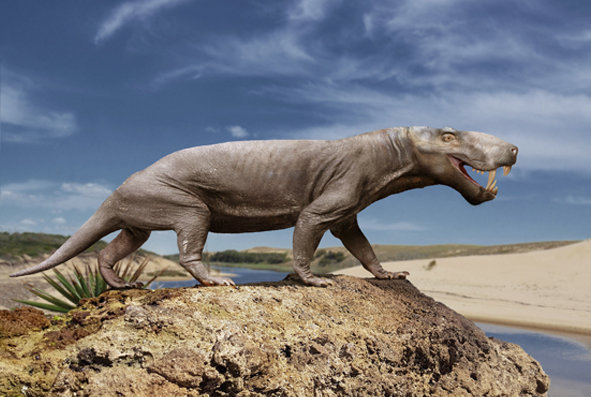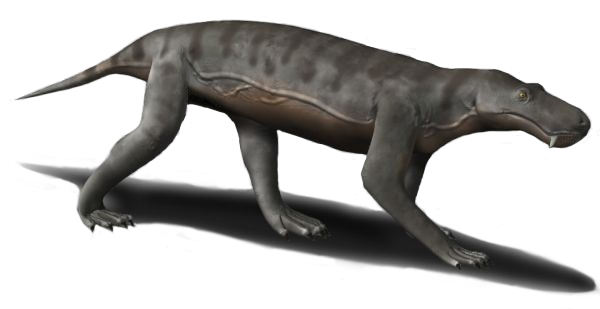|
Arctognathus Curvimola Old
''Arctognathus'' is an extinct genus of gorgonopsids that throve during the Late Permian in the Karoo basin of what is now South Africa. Discovery A carnivore, like all gorgonopsid, ''Arctognathus'' was given its name ("Bear jaw") in reference to its short and rounded snout. There is only one recognized species, ''A. curvimola''. Description It was a small gorgonopsid with a total length estimated at 1.1 m and an 18 cm skull. Classification Below is a cladogram from the phylogenetic analysis of Gebauer (2007): See also * List of therapsids This list of therapsids is an attempt to create a comprehensive listing of all genera that have ever been included in the Therapsida excluding mammals and purely vernacular terms. The list includes all commonly accepted genera, but also genera tha ... References Bibliography * * Gorgonopsia Prehistoric therapsid genera Lopingian synapsids of Africa Fossil taxa described in 1911 Taxa named by Robert Broom Lopin ... [...More Info...] [...Related Items...] OR: [Wikipedia] [Google] [Baidu] |
Permian
The Permian ( ) is a geologic period and stratigraphic system which spans 47 million years from the end of the Carboniferous Period million years ago (Mya), to the beginning of the Triassic Period 251.9 Mya. It is the last period of the Paleozoic Era; the following Triassic Period belongs to the Mesozoic Era. The concept of the Permian was introduced in 1841 by geologist Sir Roderick Murchison, who named it after the region of Perm in Russia. The Permian witnessed the diversification of the two groups of amniotes, the synapsids and the sauropsids ( reptiles). The world at the time was dominated by the supercontinent Pangaea, which had formed due to the collision of Euramerica and Gondwana during the Carboniferous. Pangaea was surrounded by the superocean Panthalassa. The Carboniferous rainforest collapse left behind vast regions of desert within the continental interior. Amniotes, which could better cope with these drier conditions, rose to dominance in place of th ... [...More Info...] [...Related Items...] OR: [Wikipedia] [Google] [Baidu] |
Cyonosaurus
''Cyonosaurus'' is a genus of gorgonopsian therapsids from the late Permian and possibly early Triassic of South Africa. ''Cyonosaurus'' was in length, with a skull in length. The type species ''Cyonosaurus longiceps'' was named in 1937. See also * List of therapsids This list of therapsids is an attempt to create a comprehensive listing of all genera that have ever been included in the Therapsida excluding mammals and purely vernacular terms. The list includes all commonly accepted genera, but also genera tha ... References * Vertebrate Palaeontology by Michael J. Benton paleodb.org* Sigogneau D. 1970. Révision systématique des Gorgonopsiens sud-africains. Cahiers de Paléontologie: 417 Gorgonopsia Prehistoric therapsid genera Lopingian synapsids of Africa Fossil taxa described in 1937 Lopingian genus first appearances Lopingian genus extinctions {{paleo-therapsid-stub ... [...More Info...] [...Related Items...] OR: [Wikipedia] [Google] [Baidu] |
Clelandina
''Clelandina'' is an extinct genus of rubidgeine gorgonopsian from the Late Permian of ''Cistecephalus'' Assemblage Zone of South Africa. It was first named by Broom in 1948. The type and only species is ''C. rubidgei''. It is relatively rare, with only four known specimens. Description ''Clelandina rubidgei'' has an extraordinarily small sclerotic ring relative to the size of its orbit, which implies that it was diurnal. It is the only rubidgeine with a preserved sclerotic ring, so it is unknown whether this trait was shared by other members of the subfamily. Like all rubidgeines, it was relatively large, with a skull up to 36 cm long. It had reduced dentition, with the teeth posterior to the canines being absent and replaced with a bony ridge. The skull has heavily pachyostosed, with massive rugose bosses. Classification ''Clelandina'' shares many characteristics with the contemporary ''Rubidgea'', and is currently recognized as the sister taxon of this genus. Tog ... [...More Info...] [...Related Items...] OR: [Wikipedia] [Google] [Baidu] |
Sycosaurus
''Sycosaurus'' is an extinct genus of rubidgeine gorgonopsians from the Usili Formation (Songea Group Songea is the capital of Ruvuma Region in southwestern Tanzania. It is located along the A19 road. The city has a population of approximately 203,309, and it is the seat of the Roman Catholic Archdiocese of Songea. Between 1905 and 1907, the ...) of Tanzania. It was medium-sized, about 1.2 m in length. It was first named by Haughton in 1924, and contains two species, ''S. laticeps'' and ''S. nowaki''.Kammerer CF. (2016) Systematics of the Rubidgeinae (Therapsida: Gorgonopsia) PeerJ 4:e1608 https://doi.org/10.7717/peerj.1608 References Gorgonopsia Prehistoric therapsid genera Permian synapsids of Africa Fossils of Tanzania Fossil taxa described in 1924 Taxa named by Friedrich von Huene {{paleo-therapsid-stub ... [...More Info...] [...Related Items...] OR: [Wikipedia] [Google] [Baidu] |
Rubidgea
''Rubidgea'' is a genus of gorgonopsid from the upper Permian of South Africa and Tanzania, containing the species ''Rubidgea atrox''. The generic name ''Rubidgea'' is sometimes believed to be derived from the surname of renowned Karoo paleontologist, Professor Bruce Rubidge, who has contributed to much of the research conducted on therapsids of the Karoo Basin. However, this generic name was actually erected in honor of Rubidge's paternal grandfather, Sydney Rubidge, who was a renowned fossil hunter. Its species name ''atrox'' is derived from Latin, meaning “fierce, savage, terrible”. ''Rubidgea'' is part of the gorgonopsian subfamily Rubidgeinae, a derived group of large-bodied gorgonopsians restricted to the Late Permian (Lopingian). The subfamily Rubidgeinae first appeared in the ''Tropidostoma'' Assemblage Zone. They reached their highest diversity in the '' Cistecephalus'' and ''Daptocephalus'' assemblage zones of the Beaufort Group in South Africa. History of disc ... [...More Info...] [...Related Items...] OR: [Wikipedia] [Google] [Baidu] |
Aelurognathus
''Aelurognathus'' is an extinct genus of gorgonopsian therapsids from the Permian of South Africa. Discovery The type species is ''Aelurognathus tigriceps'', originally named ''Scymnognathus tigriceps'' by South African paleontologists Robert Broom and Sydney H. Haughton in 1913, and later assigned to the new genus ''Aelurognathus'' by Haughton in 1924. ''Scymnognathus parringtoni'' von Huene, 1950, previously assigned to ''Aelurognathus'', is now classified as a species of '' Sauroctonus''. ''Aelurognathus nyasaensis'' Haughton, 1926 is not referable to the genus.Kammerer CF. (2016) Systematics of the Rubidgeinae (Therapsida: Gorgonopsia) PeerJ 4:e1608 https://doi.org/10.7717/peerj.1608 Palaeobiology A broken tooth beside the skeleton of a dicynodont from the ''Tropidostoma'' Assemblage Zone has been attributed to ''Aelurognathus'', indicating that it scavenged. The bones of the back of the skeleton are the most scattered, suggesting that the ''Aelurognathus'' individuals ... [...More Info...] [...Related Items...] OR: [Wikipedia] [Google] [Baidu] |
Rubidgeinae
Rubidgeinae is an extinct subfamily of gorgonopsid therapsids known only from Africa. They were among the largest gorgonopsians, and their fossils are common in the Cistecephalus and Daptocephalus assemblage zones of the Karoo Basin. They lived during the Late Permian, and became extinct at the end of the Permian. Description Rubidgeines were large, quadrupedal carnivores of the family Gorgonopsidae. Their largest teeth are their upper canines, which were blade-like and had well-developed serrations. Their postcanine teeth were small and conical, but were also frequently serrated. Tooth replacement was rapid relative to basal therocephalians. Rubidgeines can be distinguished from other gorgonopsians by the absence of a blade-like parasphenoid bone and reduced or absent preparietal bone. The jugal bone, while narrow in most gorgonopsians, was often broadly expanded in rubidgeines. The largest rubidgeins were '' Dinogorgon'' and ''Rubidgea''. Paleobiology Rubidgeines were ... [...More Info...] [...Related Items...] OR: [Wikipedia] [Google] [Baidu] |
Inostrancevia
''Inostrancevia'' is an extinct genus of carnivorous therapsids, containing the largest members of gorgonopsians, predators characterized by long, saber-tooth-like canines. The various species inhabited European Russia during the Upper Tatarian (Vyatskian), a Russian regional stage equivalent to the Wuchiapingian and Changhsingian stage of the Late Permian period, dating from approximately 259 to 252.3 million years ago. The genus name was described posthumously, after the Bolshevik Revolution, by the Russian paleontologist Vladimir P. Amalitsky in 1922, in honor of geologist Aleksandr Inostrantsev. The first fossils attributed to ''I. alexandri'' are found in Arkhangelsk Oblast, near the Northern Dvina at the end of the 19th century, making it the first gorgonopsian known from Russia, the only place outside Africa where they are officially recognized. Some fossils of the species in question are among the most complete remains of gorgonopsians ever identified to date, t ... [...More Info...] [...Related Items...] OR: [Wikipedia] [Google] [Baidu] |
Lycaenops
''Lycaenops'' ("wolf-face") is a genus of carnivorous therapsids. It lived during the Middle Permian to the early Late Permian, about 260 mya, in what is now South Africa. Description ''Lycaenops'' measured about and weighed up to . Like the modern-day wolves from which it takes its name, ''Lycaenops'' had a long and slender skull, with a set of dog-like fangs set into both its upper and lower jaws. These pointed canine teeth were ideal for the use of stabbing and/or tearing at the flesh of any large prey that it came upon. ''Lycaenops'' most likely hunted small vertebrates such as reptiles and dicynodonts. ''Lycaenops'' walked and ran with its long legs held close to its body. This is a feature found in mammals, but not in more primitive amniotes, early reptiles, and synapsids such as pelycosaurs, whose legs are positioned to the sides of their bodies. The ability to move like a mammal would have given ''Lycaenops'' an advantage over other land vertebrates, since it would ha ... [...More Info...] [...Related Items...] OR: [Wikipedia] [Google] [Baidu] |
Gorgonops
''Gorgonops'' (from el, Γοργών 'Gorgon' and 'eye, face', literally 'Gorgon eye' or 'Gorgon face') is an extinct genus of gorgonopsian therapsids, of which it is the type genus, having lived during the Late Permian (Wuchiapingian), about 260–254 million years ago in what is now South Africa. Despite its popularity, ''Gorgonops'' is a medium-sized gorgonopsian (about long maximum), regularly confused by the general public with the more massive ''Inostrancevia'', known from Russia, due to their similar appearance and the various media that tend to refer them by the name of the group they belong rather than by their genus names, which does not help in differentiation. History of discovery The holotype of the type species, ''Gorgonops torvus'', was in 1876 one of the first therapsids described, by Richard Owen, who also coined the name "Dinosauria" on the basis of the first known dinosaur fossils. It was also used as the type for which Richard Lydekker described the famil ... [...More Info...] [...Related Items...] OR: [Wikipedia] [Google] [Baidu] |
Eoarctops
''Eriphostoma'' is an extinct genus of gorgonopsian therapsids known from the Middle Permian (middle Capitanian stage) of ''Tapinocephalus'' Assemblage Zone, South Africa. It has one known species, ''Eriphostoma microdon'', and was first named by Robert Broom in 1911. It is the oldest known gorgonopsian and among the smallest and most basal members of the clade. Description Gorgonopsians were a morphologically conservative group, and like all gorgonopsians, ''Eriphostoma'' would have been a quadrupedal predator. It was among the smaller members of the group, with a skull less than long. It had a relatively short, deep snout and large orbits compared to other gorgonopsians. Like all gorgonopsians, it had five incisors and a canine tooth on each side of the upper jaw, but it had only three small postcanine teeth in its maxilla. The palate of ''Eriphostoma'' has delta-shaped palatine bosses covered in numerous teeth, like ''Gorgonops'' and many basal therapsids, but not more de ... [...More Info...] [...Related Items...] OR: [Wikipedia] [Google] [Baidu] |







.jpg)

